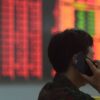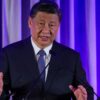Technology
The largest questions going through Bulky Tech forward of profits
Visitors together with Mark Zuckerberg, Lauren Sanchez, Jeff Bezos, Sundar Pichai and Elon Musk attend the foundation of Donald J. Trump within the U.S. Capitol Rotunda in Washington, D.C., on Jan. 20, 2025. Trump takes workplace for his 2nd time period because the forty seventh president of the U.S.
Julia Demaree Nikhinson | Getty Photographs
As tech’s megacap firms input first-quarter profits season this age, get able to listen to one guarantee on repeat: dubiousness.
President Donald Trump’s on-again, off-again way to price lists has created marketplace chaos this moment — together with 5 days of large strikes for the Nasdaq — as traders struggle to gauge the hour affect on income and profits for American firms that depend on imports.
Past the rise in prices are the follow-on results, such because the most likely drop-off in advert spending that incorporates tighter budgets and the possible slowdown in shopper spending that might consequence from upper costs and emerging unemployment.
Trump’s price lists face virtually common disapproval within the company global, which was sunlit as trillions of bucks in price evaporated in a question of days, and one of the president’s maximum vocal supporters, together with Elon Musk, voiced opposition.
Past being wicked for industry, the tariff image adjustments through the generation, making it virtually not possible for firms to devise for the hour when taking into account the place to assemble, whether or not to proceed hiring and the way aggressively to marketplace merchandise.
On April 9, following 4 days of marketplace turmoil, Trump dropped price lists to ten% for many business companions (week expanding the levy on China to 145%) for 90 days to permit negotiations with the ones nations. Since upcoming, the Trump management has signaled that telephones, computer systems and chips could be discharged from the pristine price lists, however the president upcoming added to the hesitancy through casting suspicion at the period of the exemptions, which have been considered as a boon maximum significantly for Apple.
When Tesla kicks off tech profits on Tuesday, adopted through Alphabet on Thursday, govt groups will most likely face forward-looking questions that can be tough to respond to.
Meta, Microsoft, Amazon and Apple are all slated to file effects upcoming age. Chipmaker Nvidia studies in past due Might.
As of Thursday’s near, the Nasdaq was once i’m sick 16% for the occasion and six% in April. The primary quarter was once the worst for the index in virtually 3 years.
Listed below are one of the key problems going through each and every tech megacap, to deliver of once they file:
Tesla
A Tesla automobile showroom stands doused in blue paint following vandalism through activists of the gang Untouched Future on March 31, 2025 in Berlin, Germany.
Omer Messinger | Getty Photographs
Tesla’s Tuesday file lands towards a murky backdrop for the electrical automobile maker.
The retain is i’m sick 40% for the occasion to this point later extreme out its worst quarter since 2022 in March. The big story has been Musk’s many distractions outside of Tesla, most notably his work slashing the federal government as part of the Trump administration.
Tariffs are also a problem, as the company relies on suppliers in Mexico and China for items like automotive glass, printed circuit boards and battery cells, among other parts essential for the production of its cars. Tesla has sought an exemption from the U.S. Trade Representative for equipment imported from China that it uses in its factories.
On the company’s fourth-quarter earnings call in January, Tesla CFO Vaibhav Taneja cautioned shareholders that the Trump administration’s tariffs would have an “impact on our business and profitability.”
For the first quarter, analysts are projecting revenue growth of less than 1% from a year earlier, followed by a slight year-over-year slippage in the second quarter. Investors will want to see if Musk can provide any clarity on how costly tariffs could be going forward. Musk has made his thoughts on the matter fairly clear, calling Trump’s top trade advisor and tariff proponent Peter Navarro a “moron” and “dumber than a sack of bricks.”
Tesla’s business was already under pressure before tariffs and uncertainty roiled markets. In early April, the company reported 337,000 vehicle deliveries in the first quarter, a 13% decline from the previous year. To win over customers in the face of a Musk-induced backlash, and to get customers to buy inventory cars when a new Model Y is on the way, the company had to offer an array of incentives and discounts in the first quarter.
Piper Sandler analysts last week revised their Tesla price target lower, saying after the first-quarter whiff on deliveries that “gross margin is probably trending near multi-year lows.”
Alphabet
Alphabet Inc. and Google CEO Sundar Pichai speaks during the inauguration of a Google Artificial Intelligence (AI) hub in Paris on February 15, 2024.
Alain Jocard | AFP | Getty Images
Google parent Alphabet faces an online ad market that’s on edge due to concerns about how Trump’s tariffs will affect the economy and business spending.
A note last week from Piper Sandler pointed to fears of an 18% impact to growth forecasts for the 2025 global ad market. Chinese discount e-commerce apps Temu and Shein, which have been big advertisers in the U.S. in recent years, are of notable concern, and Temu has already pulled way back on spending.
Retail represents at least 21% of Google ad revenue, according to estimates by Oppenheimer & Co., which said that Meta has even more exposure to ad pullbacks.
Investors are equally concerned about the cloud business, as Alphabet is a massive spender on imported data center infrastructure, and is going even bigger to keep up with the AI boom. The company has said it plans to spend $75 billion this year, mostly going toward servers and data centers to power AI and its cloud business.
It’s unclear whether Google will adjust that figure, but such a move may be necessary. Mizuho analysts wrote on April 8 that roughly 25% of Google channel partner customers have reduced spending on the company’s cloud, and “we expect that mix to increase to 50% from elevated customer hesitation” after the tariff announcement.
Though Alphabet doesn’t make a large chunk of its revenue from consumer hardware, it does produce its Pixel and Fitbit products abroad and runs its services on the most popular phone carriers. Pixel products are manufactured in India, after the company began diversifying its supply chain away from China.
Meta
(L-R) UFC CEO Dana White and Mark Zuckerberg attend the UFC 300 event at T-Mobile Arena on April 13, 2024 in Las Vegas, Nevada.
Jeff Bottari | UFC | Getty Images
Meta has a small hardware business, focused largely on selling virtual reality devices. That’s not the biggest concern for investors.
Rather, like with Google, it’s the potential impact of the tariffs on the economy and the willingness of businesses to spend on digital ads. In Meta’s case, that means ads on Facebook and Instagram.
Meta acknowledged the negative impact of a U.S.-China trade dispute in its latest annual report, noting that an motion “that reduces or eliminates our China-based advertising revenue” would “adversely affect” monetary effects. Meta’s China income was once $18.35 billion in 2024, representing a slight over 11% of overall gross sales.
Analysts say Temu and Shien constitute the majority of Meta’s China gross sales. Vault of The usa analysts wrote in a contemporary notice that Meta may just face “3% revenue exposure to Temu and Shein in the US” because of the price lists. Year the “tariff situation still remains fluid,” the company mentioned firms will loose on-line advert spending because of a weakening financial system. The analysts lowered their estimate for 2025 income through 4.4% to $179.8 billion.
Oppenheimer analysts wrote in a contemporary notice that the China business battle will harm Meta greater than Google, as it’s “more exposed to discretionary spending” and China. The company warned that businesses are much more likely to trim advert spending on social media than seek, in accordance with a March survey of advertisers from the Interactive Promoting Bureau.
The place prices is usually a worry for Meta is within the information heart, as CEO Mark Zuckerberg mentioned previous this occasion that the corporate would spend $60 billion to $65 billion in capex in 2025, calling it a “defining year for AI.” The majority of that infrastructure needs to be imported from Asia, and analysts can have enough of questions for the corporate about how a lot more it’ll must spend to proceed its AI developments.
Microsoft
Microsoft CEO Satya Nadella waves all through an match celebrating the fiftieth Per annum of Microsoft on April 4, 2025 in Redmond, Washington. The corporate additionally gave an replace on Copilot, its AI software.
Stephen Brashear | Getty Photographs Information | Getty Photographs
Microsoft makes PCs and video game consoles, but it derives most of its revenue from selling software. The company buys lots of hardware to operate cloud services for its clients, transactions that are subject to significantly higher costs due to tariffs.
In early January, Microsoft announced it was aiming to spend more than $80 billion this fiscal year on data centers capable of handling artificial intelligence workloads.
Where investors may be most concerned for Microsoft is in the company’s expansive customer base and whether Trump’s trade policies will lead clients to cut spending on products.
“There’s not a direct tariff impact, and so what we talk about is indirect,” said Brent Bracelin, an analyst at Piper Sandler. He recommends buying Microsoft shares.
Recent surveys indicate that software sales cycles are lengthening and interest in buying new software is waning, Bracelin said. Other analysts have said Microsoft, along with Salesforce, are among the software vendors that are best able to handle higher tariffs.
“We see MSFT and CRM as two of the names best positioned to weather this macro storm as they are already back at/near 2022 trough levels and can adjust spending/capex levels for this ‘new reality’ if needed to preserve” earnings and cash, Evercore ISI analysts wrote in a note earlier this month.
Amazon
Attendees walk through an exposition hall at AWS re:Invent, a conference hosted by Amazon Web Services, in Las Vegas on Dec. 3, 2024.
Noah Berger | Getty Images
Amazon’s position as an e-commerce juggernaut gives it hefty exposure to potential tariff headwinds, and not just because of consumer spending.
More than 60% of Amazon’s sales are from items sold by third-party merchants, and many of those sellers source their products from China. The remaining 40% comes from vendors Amazon purchases from directly.
Within days of Trump’s new tariffs, Amazon canceled some of those merchandise orders from vendors in China, while Amazon sellers have said they’re considering raising the price of their products.
Investors will be listening for any commentary around the impact of tariffs on its online stores business, especially as Amazon’s summer Prime Day discount event nears. Amazon CEO Andy Jassy told CNBC last week the company will work to keep prices low on its website, but that sellers may need to “pass the cost” of tariffs on to consumers.
“Amazon is probably the best-positioned company in retail and e-commerce to take advantage of the chaotic situation from tariffs and shifting global supply chains,” Barclays analysts, who have a buy rating on Amazon, wrote in a recent report. “The pandemic was a precursor of this, during which Amazon was able to gain share and move quicker than peers despite its massive size.”
The company’s advertising unit could be “pressured more if trade wars get worse,” analysts at Cantor Fitzgerald, who also recommend buying the stock, wrote in a note on April 15. Most of Amazon’s ad revenue comes from sponsored product ads that appear in search results on its website. Businesses could pull back on their ad spend as they look to conserve costs or reduce traffic to products sourced from China.
And like the other hyperscalers, Amazon has all of the potential added costs associated with tariffs on advanced chips and other data center equipment, depending on what products end up getting exempted. Amazon Web Services is the market leader in cloud infrastructure, ahead of Microsoft and Google.
Apple
People shop at an Apple store in Grand Central Station in New York on April 4, 2025.
Michael M. Santiago | Getty Images
Apple has outsized exposure to Trump’s tariffs, as the company generates about three-quarters of its revenue from selling devices that are mostly manufactured in Asia. While Apple got an apparent reprieve when the Trump administration suspended tariffs on computers from China earlier this month, the company still faces significant uncertainty with the possibility of another Trump shift.
Wall Street has been dumping shares of the iPhone maker, sending the stock down 8% in March and another 11% so far this month, a recognition of how damaging long-term tariffs would likely be on Apple’s business.
CEO Tim Cook, along with many of his tech counterparts, has tried cozying up to President Trump, donating to his inauguration in January and attending the event in Washington, D.C. But investors have yet to hear how Cook and the rest of the management team plan to deal with the increased costs, how the company is managing inventory and how it will all add up to affect margins.
Nvidia
Nvidia CEO Jensen Huang delivers the keynote address during the Nvidia GTC 2025 at SAP Center on March 18, 2025 in San Jose, California.
Justin Sullivan | Getty Images News | Getty Images
Nvidia’s graphics processing units (GPUs) are key to the AI infrastructure buildouts across the tech industry. While semiconductors have a tariff exemption, many of the AI servers that have driven the recent boom have been shipped to the U.S. as mostly finished computers, putting them at risk of tariffs.
Since an AI server can cost upwards of $50,000, even small tariffs could have a big impact on costs. And the almost tenfold increase in Nvidia’s stock price over the past two calendar years has baked into it an assumption that sales and profit margins will keep inflating.
Investors will want to hear from CEO Jensen Huang about his relationship with Trump, given the potential importance of that dynamic.
Nvidia said last week that it would produce its “AI supercomputers” in Texas, days after Huang met with Trump at his Mar-a-Lago membership in Florida. Nvidia additionally mentioned it might purchase and bundle chip manufacturing services and products from firms in Arizona. The corporate mentioned it might “produce” a half-trillion bucks in AI infrastructure over the upcoming 4 years.
The White Space praised the go, and mentioned in a press release that Nvidia was once an “American-made chips boom.” Nvidia’s plans for U.S. manufacturing will depend at the corporate getting exceptions for most of the portions it’ll wish to develop the computer systems.
Nvidia’s worry with the federal government isn’t with reference to price lists. The corporate mentioned ultimate age that it’ll whisk a quarterly price of about $5.5 billion fix to exporting H20 graphics processing devices to China and alternative locations.
Right through President Joe Biden’s management, the U.S. limited AI chip exports and upcoming up to date the foundations to cancel the sale of extra complicated AI processors. The H20 is an AI chip for China that was once designed to agree to U.S. export restrictions. It generated an estimated $12 billion to $15 billion in income in 2024.
— CNBC’s Lora Kolodny, Jennifer Elias, Jonathan Vanian, Jordan Novet, Annie Palmer and Kif Leswing contributed to this file.
WATCH: Tech profits mirage





